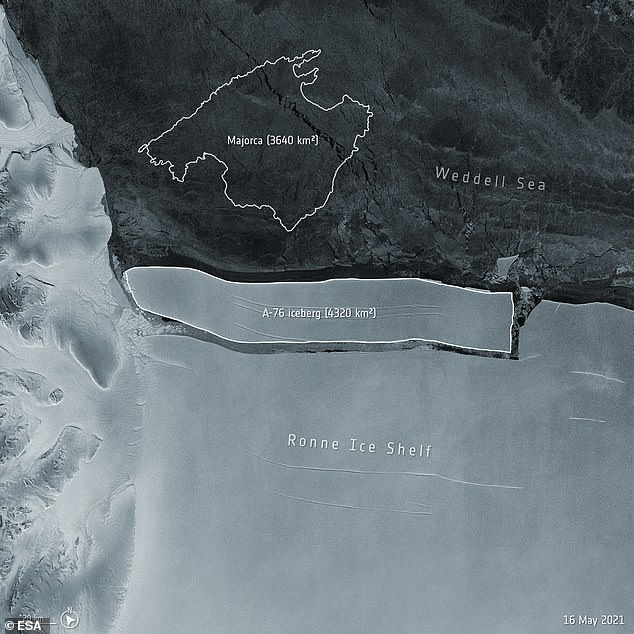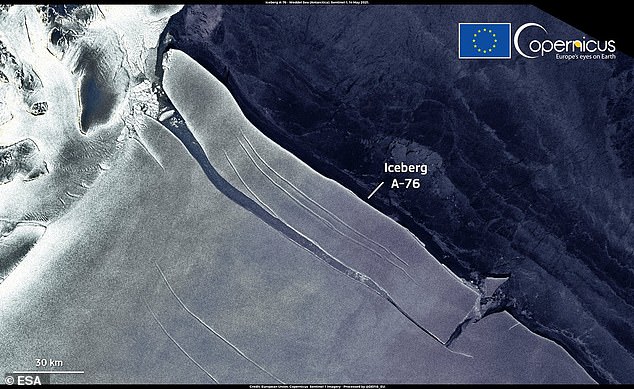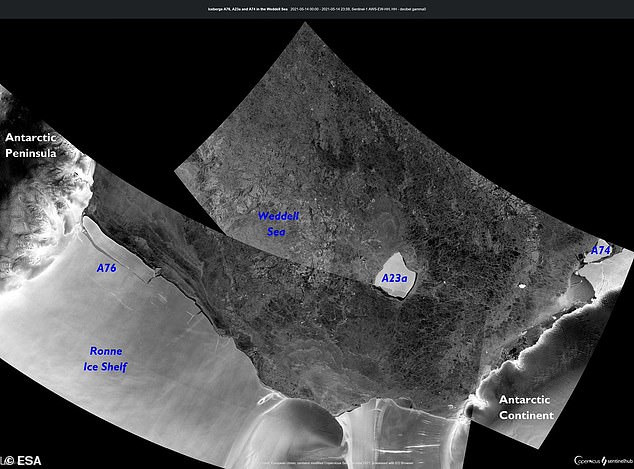Meet the world's biggest iceberg: Huge 1,667 square mile block that's even bigger than MAJORCA has broken away from the Antarctic ice shelf, European Space Agency reveals
- The massive block of ice broke off from the Ronne Ice Shelf in the Weddell Sea
- It is 105 miles long by 15 miles wide and was spotted by experts on May 14
- The British Antarctic Survey first saw it in images from ESA's Sentinel satellites
- Experts from the British Antarctic Survey say this latest iceberg calving is a natural event that was expected rather than something linked to climate change
A huge 1,667 square mile block of ice has broken away from the Antarctic ice shelf, according to the European Space Agency, making it the world's largest iceberg.
The splitting of an iceberg is known as 'calving' and this mammoth beast, slightly larger than Majorca, came away from the western side of the Ronne Ice Shelf.
The iceberg, dubbed A-76, was spotted in images captured by the ESA Copernicus Sentinel-1 mission on May 14, and is now floating in the Weddell Sea in Antarctica.
It measures around 1,667 square miles in size, or 105 miles long by 15 miles wide – currently making it the largest iceberg in the world.
Experts from the British Antarctic Survey say this latest iceberg calving is a natural event that was expected, rather than something linked to climate change.

A huge 1,406 square mile block of ice has broken away from the Antarctic ice shelf, according to the European Space Agency, making it the world's largest iceberg
A-76 has snatched first place for largest berg in the world from the iceberg A-23A, which is also in the Weddell Sea, and is about 1,498 square miles in size.
It is some way off the largest recorded icebergs though, with B15, spotted in 2000 reaching a massive 4,200 sq miles and A68, spotted in 2017 covering 2,239 sq miles.
Spotting this new berg was a global effort, with the British Antarctic Survey the first to notice it had broken off, with the discovery then confirmed by the US National Ice Center using ESA Copernicus Sentinel-1 satellite images.
The Sentinel-1 mission consists of two polar-orbiting satellites that rely on C-band synthetic aperture radar imaging, returning data regardless of whether it is day or night, allowing year-round viewing of remote regions like Antarctica.
Icebergs are traditionally named from the Antarctic quadrant in which they were originally sighted, then a sequential number, then, if the iceberg breaks, a sequential letter, ESA explained.
Earlier this year the iceberg A68, originally 2,240 square miles, continued breaking up into an 'alphabet soup' of fragments drifing in the ocean north of Antarctica.
It originally formed in July 2017 when a huge crack in Antarctica's Larsen C ice shelf caused the trillion ton iceberg to break off from the icy southern continent.
The floating mass began to break up into smaller parts as it drifted some 1,200 miles (1930 km) north into the southern Atlantic Ocean, with the largest chunk about 33 miles long.

A-76 has snatched first place for largest berg in the world from the iceberg A-23A, which is also in the Weddell Sea, and is about 1,498 square miles in size

Spotting this new berg was a global effort, with the British Antarctic Survey the first to notice it had broken off, with the discovery then confirmed by the US National Ice Center using ESA Copernicus Sentinel-1 satellite images
The calving of ice from the ice sheets of Antarctica is a big concern for researchers, as the continent holds enough freshwater to raise global sea levels by approximately 8.2 feet (2.5 meters).
Laura Gerrish from the British Antarctic Survey said the A76 and A74 icebergs were 'part of natural cycles on ice shelves that hadn't calved anything big for decades.'
She added that it is 'important to monitor the frequency of all iceberg calving,' due to the risk of sea level rises from warmer temperatures, but that 'these are all expected for now.'
Most watched News videos
- Moment racism row breaks out on Avanti West Coast train
- Moment 'racist' Avanti West Coast passenger gets instant karma dose
- Passenger captures moment two planes collide on tarmac
- Man hides in toilet as Orebro shooter can be heard firing
- Moment car speeds past shops seconds before crash kills occupants
- Karoline Leavitt reveals list of where USAID money goes
- Prisoners escape as Goma's Munzenze prison engulfed in flames
- Mum threatens private school student while inside the classroom
- Furious Los Angelenos chase down arsonist trying to start new fire
- Etienne Ancelet spotted outside following death of daughter
- Kay Burley retires from Sky news after 36 years at the desk
- Mum who stormed into classroom threatening child breaks silence



























































































































































































































































































